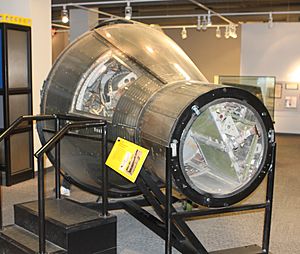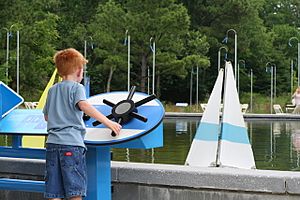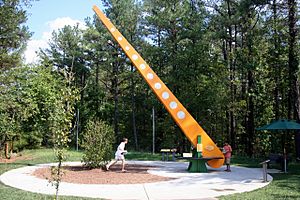Museum of Life and Science facts for kids
| Established | 1946 |
|---|---|
| Location | Durham, North Carolina |
| Type | science museum, children's museum, and zoo |
| Association of Science-Technology Centers | |
|
|
The Museum of Life and Science is a super cool place in Durham, North Carolina. It's a huge science museum, a children's museum, and even a zoo, all rolled into one! The museum covers about 84 acres, which is like 60 football fields.
You'll find the museum in the Northgate Park neighborhood. It's split into two main parts by Murray Avenue. On the north side, you'll discover the main building, the Butterfly House, Hideaway Woods, the Farmyard, and the Dinosaur Trail. There's also a fun train ride called the Ellerbe Creek C.P. Huntington train. The museum has both indoor and outdoor areas where you can learn and play. The south side is mostly for parking and offices now.
Contents
Discovering the Museum's Past
The Museum of Life and Science has grown a lot over the years. A person named Richard Wescott, also known as Dick, was very important to its growth. He started as a volunteer and later became the director in 1970. Back then, the museum was just a small building.
By the early 1970s, the museum had many buildings. It was filled with amazing collections, models, and exhibits. With help from friends and experts, the museum built one of the best collections of space items in the country. This included a special Lunar Landing Module (LEM) and a unique walk-through exhibit about launching rockets. This exhibit was even designed for visitors who couldn't see.
The museum also started collecting live animals. Dick Wescott worked with others to create an exhibit around an old rock quarry. The narrow-gauge railroad, which you can still ride today, was the first step in building a special home for native animals. Dick also designed and built the Dinosaur Trail. This trail has more than twenty life-size dinosaur models. They have been along the banks of Ellerbe Creek for about thirty years!
Exciting Exhibits to Explore
The Museum of Life and Science has many different exhibits. Each one offers a unique way to learn and have fun.
Main Museum Building: Indoor Adventures
The main museum building has two floors packed with things to do. You can learn about weather, sound, and math. There are also exhibits about health, building, and engineering. You can even see local North Carolina wildlife. There's a special play area for younger kids (under 6) and a hands-on lab. The lab often changes its topics and activities, so there's always something new to try!
The Farmyard: Meet the Animals
At the Farmyard, you can meet many different farm animals. You might see a donkey, goats, chickens, bulls, and pigs. Recently, some alpacas have joined the farm family too! The Farmyard shows how zoos keep animals happy and healthy. You can even have up-close experiences with the animals, guided by their keepers. There are also other hands-on activities to enjoy.
Hideaway Woods: Nature Play
Opened in 2015, Hideaway Woods is a two-acre outdoor area. It's all about discovering nature! You can explore eight amazing tree houses and a flowing stream. There are also cool nature sculptures. You can relax in hammocks or explore a special area just for younger kids. This exhibit helps you see how important it is to play and explore in nature.
Aerospace: Journey to Space

The museum is famous for its Aerospace exhibit. This exhibit focuses on the early days of the NASA space program. Many of the items you see here are on loan from the National Air and Space Museum. These include important items from the Project Apollo missions, like a Moon rock and Neil Armstrong's dosimeter (a device to measure radiation). You can also see a test version of an Apollo Command Module and part of an Apollo Lunar Rover. There's even a full-sized model of a Lunar Module.
The Aerospace exhibit also has a hands-on area called Launch Lab. Here, you can launch paper airplanes and use wind tunnels to see how things fly.
BioQuest: Outdoor Explorations
In the mid-1990s, the museum started a big plan called BioQuest. This plan added many new outdoor exhibits. These included the Magic Wings Butterfly House, Explore the Wild, Catch the Wind, and the Dinosaur Trail and Dig.
Magic Wings Butterfly House: A Tropical Paradise
A very popular part of the museum is the three-story glass Magic Wings Butterfly House. It opened in 1999. Inside, you'll find hundreds of tropical butterflies flying around. There are many different kinds of butterflies and beautiful tropical plants. The Bayer CropScience Insectarium is also inside. It has amazing insects from all over the world. This was the first part of the BioQuest expansion to be finished.
Explore the Wild: Animal Conservation
Explore the Wild is home to American black bears, red wolves, lemurs, and radiated tortoises. You can walk along a 900-foot boardwalk that goes over a 6-acre natural area. There are also many multimedia exhibits. This exhibit opened in 2006.
The museum helps protect red wolves and radiated tortoises. In 2017, a pair of red wolves at the museum had four pups. These pups were a big deal because they made up 2% of all red wolves in the world at that time! The museum also joined efforts to save radiated tortoises in 2018. They even held a fundraiser to help these tortoises.
Catch the Wind: The Power of Air
Catch the Wind opened in 2007. It has seven exhibits that show how wind affects our world. There's a 30-foot interactive tower that drops large models of tree seeds. This shows how wind helps seeds travel. The main attraction is a 5,000-square-foot pond where you can sail remote-controlled sailboats.
You can also listen to stories, poems, and narratives about the wind at different kiosks.
Dinosaur Trail: Prehistoric Giants
The Dinosaur Trail is a long-time favorite. It has many life-size models of dinosaurs and other prehistoric creatures along a woodland path. You can even see a Brontosaurus from Murray Avenue! The creatures were built by Richard Wescott over four years and finished in 1967. The trail was renamed the Dinosaur Trail in 1986.
A new dinosaur trail opened in 2009. It's in a different part of the museum. This new trail has life-size models of dinosaurs like Albertosaurus, Styracosaurus, and Maiasaura. There's even a reclining juvenile Parasaurolophus that visitors can climb on, which is very popular! You can also try an interactive fossil dig area. Here, you can use shovels and screens to search for shark teeth, coral, and other fossils from an old mine.
Earth Moves: Geology Fun
The "Earth Moves" exhibit opened in 2019. It's a cool way to learn about geology and how it affects our daily lives. You can explore a cave made from sandstone. You can also change the flow of a 20-foot waterfall and splash in it! Plus, you can build towers, walls, and arches out of stone, and even sculpt sand.



